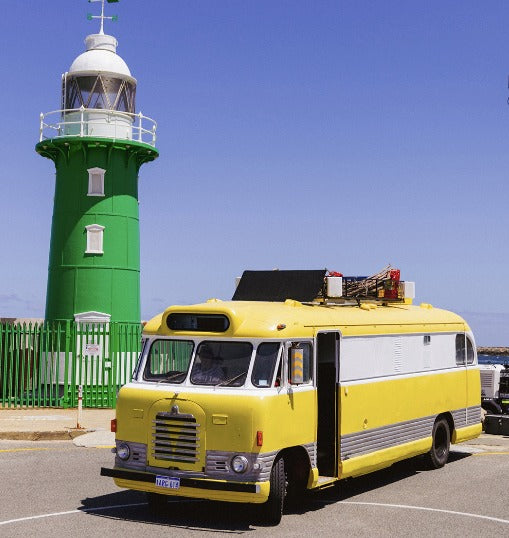
The Yellow Bus
An Inspiring Intersection of Innovation and Accessibility in Art and Culture
In 2023, Juluwarlu CEO Lorraine Coppin embarked on an innovative project that transformed a 1955 vintage Bedford bus into an immersive, mobile art space. Collaborating with artist Dr. Andrew Sunley Smith, Coppin envisioned the Yellow Bus as a vehicle for both literal and cultural transportation, designed to house Yindjibarndi arts and interactive learning materials, traveling to different locations to engage larger audiences with Yindjibarndi culture while at the same time reconnecting the Yindjibarndi community with their history.
The Yellow Bus symbolizes much more than an artistic endeavor—it’s a living archive of collective memory, embodying the profound connection between Yindjibarndi people and their Ngurra (Country). Lorraine Coppin’s inspiration for the project stems from her own fond childhood experiences in Roebourne, where people were often transported on a yellow bus out onto Yindjibarndi Country. For many, these trips were a rare opportunity to return to their ancestral lands, spending precious time with Elders who shared knowledge, stories, and cultural practices during a period when families had been forcibly relocated to town camps on Ngarluma Country. As Lorraine recalls,
“The Yellow Bus gave us a time that we looked forward to every weekend and on holidays. It promised us connection with Elders and to take us back home. It taught us how to look after family and each other.”


By reconstructing these memories and turning them into a contemporary art experience, Coppin is challenging the enduring effects of colonization while offering a pathway for healing and cultural preservation. The Yellow Bus project not only highlights the power of storytelling and tradition but also offers audiences—both Aboriginal and non-Aboriginal—an opportunity to engage with Yindjibarndi history in new and innovative ways.
Coppin’s work with the Yellow Bus echoes another visionary woman in the art world: Elizabeth Ann MacGregor OBE, former Director of Sydney’s Museum of Contemporary Art (MCA). Before her 22-year tenure transforming MCA from what she called "a venue for wankers" into one of Australia’s most respected art institutions, MacGregor began her career in the 1980s as the curator and driver of the Scottish Arts Council’s Travelling Gallery. Much like Lorraine Coppin’s Yellow Bus, MacGregor’s Travelling Gallery was a converted bus that toured remote and rural areas, making contemporary art accessible to communities who rarely had the chance to engage with it. Remarkably, the Travelling Gallery is now also yellow, creating a symbolic link between these two vehicles of cultural outreach.
MacGregor’s work was driven by a deep commitment to accessibility in the arts. Her vision for the Travelling Gallery was to bring the work of living artists to the people, breaking down the barriers between high art and everyday life. She believed in the importance of engaging new audiences, breaking down the white walls of the modern gallery space. This sense of mission parallels Coppin’s approach to the Yellow Bus, where contemporary art is a medium for cultural storytelling, with the added depth of Yindjibarndi tradition and lived experience.

Both Coppin and MacGregor demonstrate a shared belief that art is not a static object to be confined to galleries and museums but a dynamic force that should be brought to the people, wherever they are. This philosophy aligns with the idea of Relational Aesthetics (art’s value comes from its ability to facilitate human interaction and create social connections). Sunley Smith, who collaborates with Coppin on the Yellow Bus, draws on this philosophy, emphasizing that the project is about more than just presenting art—it’s about creating an experience where art, culture, and community merge, enabling participants to engage actively with Yindjibarndi knowledge.


The Yellow Bus project recently returned to Roebourne as part of the Yindjibarndi Expo, marking the beginning of the second phase of its journey. Over the coming months, the project will continue to evolve, integrating cutting-edge technologies from collaborators like Multistory and Lightwell to enhance the immersive storytelling experience. Lorraine Coppin, with her visionary leadership, is building a bridge between the past and the future, utilizing art to nurture cultural pride and facilitate deeper understanding between different communities.
In reflecting on these two women—Lorraine Coppin and Elizabeth Ann MacGregor—it’s clear that both have made profound contributions to the arts, not only as cultural leaders but as innovators in accessibility. Through their respective projects, they’ve demonstrated that art can be both a transformative personal experience and a collective act of cultural preservation. Whether it’s a bus traversing the Scottish Highlands or the vast expanses of Yindjibarndi Country, their shared mission to make art and culture available to everyone is a testament to the power of creativity in fostering connection and understanding.
To learn more or be part of the journey, email us at wanthiwa@juluwarlu.com.au.
Images courtesy of Ngaarda Media.
